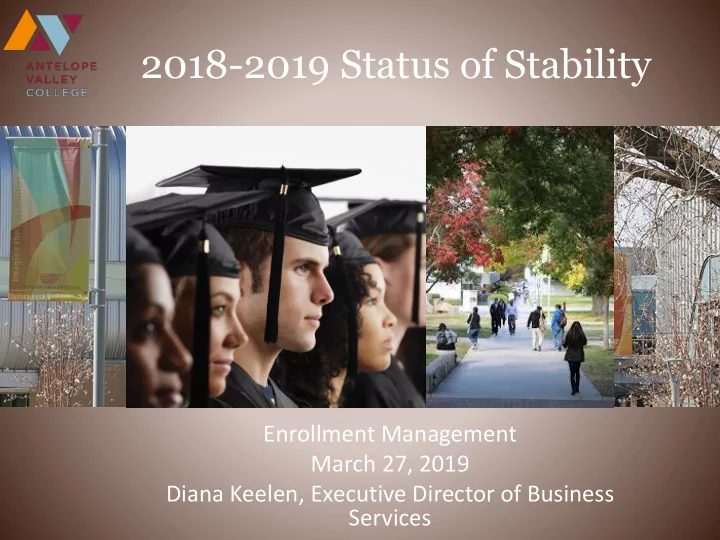

2018-2019 Status of Stability Enrollment Management March 27, 2019 Diana Keelen, Executive Director of Business Services
Topics • Student Centered Funding Formula (SCFF) • Status of Stability • Strategic Enrollment Management • Integration of Initiatives
Student-Focused Funding Formula Year 1: • Hold Harmless held to 70% Base (Enrollment) 3 year average FTES 2017-2018 levels plus 20% Supplemental Grant COLA for 3 years 10% Student Success Initiative Grant • Noncredit & CDCP separate Year 2: - On Hold Using Year 1 per Gov Proposal • Oversight Council 65% Base (Enrollment) created (Governor’s 20% Supplemental Grant Rep, Senate Rules 15% Student Success Initiative Grant Committee & Speaker) • Basic Skills, SSSP & Year 3: Student Equity 60% Base (Enrollment) Combined into one 20% Supplemental Grant allocation called the Student Equity & 20% Student Success Initiative Grant Achievement Program
Status of Stability • 2017-2018 was Year 2 of Stability. Must recoup FTES in 2018-2019, Year 3.
Spring 2017 IEPI SEM Field Survey Report
Strategic Enrollment Management (SEM) Within California Community Colleges, SEM is a shared responsibility. Student success is central to all related planning, practices, and processes. The purpose of SEM is to: • Establish comprehensive student enrollment goals that are aligned with the college’s mission and strategic plan. • Promote student success by improving access, engagement, persistence, and completion. • Ensure fiscal stability and viability by optimizing enrollments and integrating SEM into the college financial planning, budgeting, and allocation processes. • Offer quality and relevant programs with clear educational pathways, course offerings, and appropriate student support. • Implement strategies that lead to equitable access and outcomes. • Create a data-rich environment to inform decisions and evaluate strategies. • Design and implement communications and marketing with internal and external stakeholders to increase understanding of SEM and to meet SEM goals. • Increase collaboration among departments across the campus to support the enrollment program. Source: https://visionresourcecenter.cccco.edu/ask/topic/sem/sem-operational-definition
Five Pillars of Strategic Enrollment Management (SEM) Source: https://visionresourcecenter.cccco.edu, Learning Communities as a Retention and Persistence Strategy
Strategic Enrollment Management Source: https://visionresourcecenter.cccco.edu/ask/topic/sem/sem-organizing-framework
Strategic Enrollment Management Source: https://visionresourcecenter.cccco.edu/ask/topic/sem/sem-program
Strategic Enrollment Management Current Promising Practices • Cuyamaca College, Math Pathways: Developmental Education Reform – Goal to “annihilate the achievement gap” 1. Intermediate algebra with concurrent-enrollment support 2. An accelerated PreStatistics course or Stats course with concurrent-enrollment support 3. Intermediate Algebra 4. A transfer-level math course with concurrent-enrollment support – Activity-based math classrooms with contextualized teaching & learning; focus shifts from teacher to the learner • Kern CCD, Weekly Enrollment Updates sent to District Leadership including: – A brief description of activity (headcount, enrollments, and FTES) since the previous update – A summary of productivity with a comparison to the previous year – Information on fill-rates, average students per section, waitlists and low enrollment sections • Foothill, Go2Foothill Online Orientation – Different than other online orientations in that it is completely delivered by students and does not involve administrators, faculty or staff talking at students. Instead, students present the information adding their own experiences. The student-to student format is engaging and focuses on what students really need to know. • LA City College, Zero-based Scheduling – Targets set and once FTEF is determined, Dean of IE allocates the FTEF to each dept based on agreed upon model • De Anza College, Cluster Analysis for Enrollment Planning – Two-step cluster analysis using both categorical and continuous data and use them to separate individuals into groups, called clusters
Integration of Initiatives
Strategic Enrollment Management Resource Guides • Resource Guides – A Roadmap for Strategic Enrollment Management Planning – Calculating and Understanding FTES and Productivity – Data Tools and Metrics for Strategic Enrollment Management – Developing and Managing the Class Schedule – High Impact Retention, Persistence, and Success Practices for Strategic Enrollment Management – Targeted Marketing for Strategic Enrollment Management – Understanding CCC Budget and Reporting Part I (F320 Report) – Understanding CCC Budget and Reporting Part II (Exhibit C, Fifty Percent Law, and FON) – The Basics of Community College Funding • Other Tools and Resources – SEM Institutional Self-Assessment – SEM Institutional Self-Assessment Facilitator's Guide – SEM Planning FAQ – FTES Calculator • Training – Developing a Strategic Enrollment Management Academy for 2019 https://visionresourcecenter.cccco.edu/ask/topic/sem
Recommend
More recommend